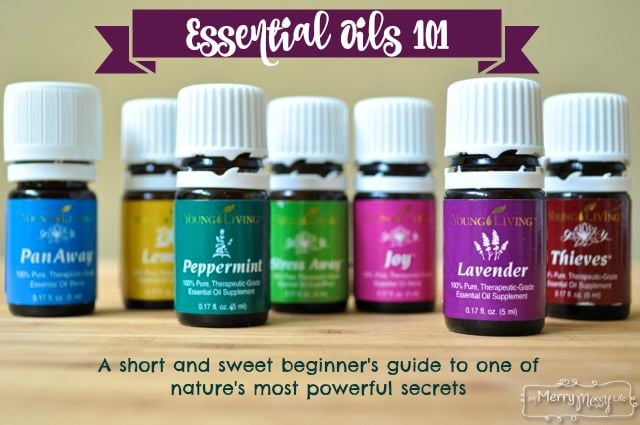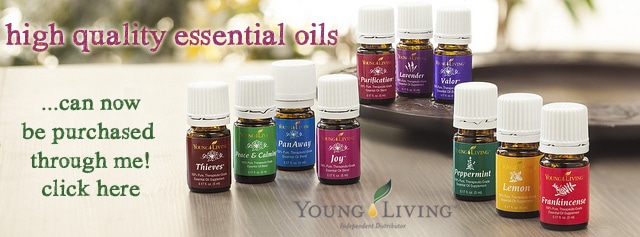Essential Oils 101 – How and Why to Use Them
Essential oils are so powerful and work with the body to help it heal itself. Here's a complete beginner's guide on how to begin using these amazing oils safely and effectively!

What Exactly Are Essential Oils?
Ever peeled an orange or squeezed a lemon and immediately noticed the strong fragrance? Or smelled a rose and was taken to another state of mind, even for a minute? You were experiencing the essential oil of the plant!
Essential oils are natural aromatic compounds found in the raw material of plants (leaves, stems, bark, petals, etc). The oils of plants contain the essence (this is where the word “essential” comes from) or scent of that particular plant. Therapeutic grade oils are extracted from the plant using steam distillation and are super concentrated, which is why they should be used with respect and caution.
They Harness the Power of Nature
I think the coolest fact about essential oils is that they are the regenerating, oxygenating, and immune defense properties of plants. In other words, they protect and support the plant and do the same in our bodies! Our bodies recognize them as nutrients and know what to do with them. According to this fantastic book, “Quick Reference Guide for Using Essential Oils,” (where to buy) they are:
“lipid-soluble and are capable of penetrating cell walls, even if the cell wall has hardened because of an oxygen deficiency. In fact, essential oils can affect every cell of the body within 20 minutes and then be metabolized like other nutrients.”
Wow! They are effective, powerful little suckers.
Some Fun Essential Oil Facts
Essential oils were commonly used long ago for their medicinal and therapeutic properties and have gained popularity today for people like me who prefer a holistic approach and non-toxic products.
- When inhaling, it takes 22 seconds for an oil to reach the brain.
- When applied topically, it takes 2-3 minutes for an oil to reach the bloodstream, 20 minutes to affect every cell in the body, and 2 1/2 hours to fully metabolize.
- It takes about 16 pounds of peppermint leaves to make one ounce of oil.
- It takes 3 tons of plant material to make 1 pound of Melissa oil.
What Can We Use them For?
Essential Oils are very versatile – I have used them to clean and purify the surfaces in my house, to support our immune systems, to deodorize, to purify the air, to create a mood, to soothe sore muscles and tension, to help power our bodies through the rough winter months, and to even help deal with the stresses and emotions of life. I use only Young Living Essential Oils (where to buy) and they can be used:
Internally
Many of the single oils may be used as dietary supplements by dropping into empty capsules to swallow, or dripping in the throat or under the tongue. I will only use Young Living Essential Oils internally as they are truly pure – many brands on the market are not and I do not trust them.
Aromatically – Diffusing and Sniffing
Diffusing and smelling oils is the easiest and safest way to use them. It's called Aromatherapy for a reason! It is also my favorite as I love to set a mood in the house with my favorite blends (like Stress Away, Valor, Joy, etc). I have also found oils are very effective to diffuse at night when my childrens' immune and respiratory system need support. I have also diffused when I'm needing energy, tired, stress relief, or just not up to par – it really helps to clear my head while I enjoy the wonderful, non-toxic fragrance!
You can even just sniff or inhale an oil straight from the bottle to get therapeutic benefits. For instance, my oldest son can feel woozy in the car, so I give him a cloth with peppermint oil on it to sniff while we drive and it helps him a lot!
Topically
Essential Oil Safety
Like I mentioned above, it takes 16 pounds of peppermint leaves to make one ounce of oil and about 85 lemons to make one ounce of lemon oil. In other words, essential oils are very concentrated, very powerful oils. A little goes a very long way, especially when it comes to applying them topically.
To Dilute or Not Dilute?
I love using essential oils on the skin as they are very effective. However, I believe this should be done with caution and have included a chart below to help you. There is quite a bit of debate when it comes to applying the oils diluted or neat – but we like to say, start low and go slow. Increase dilution as your body becomes more accustomed to essential oils. At first, I was more cautious and used a lot less than I do now. Now my body is so used to essential oils, I can be much more carefree with them. Listen to and observe your body – you'll know when you are ready to increase the dilution!

Use More Caution with Infants and Children
My children have gotten rashes even when I dilute lavender, so I always dilute essential oils for them, unless I'm applying to the bottoms of their feet. This isn't to scare you – just be cautious and treat essential oils with respect. My son accidentally got some peppermint oil near his eye one time while he was smelling it, and now if gets any essential oils on his face, even a highly diluted one, his eyes start watering.
Oil Dissolves Oil
If the oils do burn or get into an area like the eyes, water will not help to get it out, in fact, it'll make it worse! Use a carrier oil like Young Living's V-6 oil, organic olive oil (where to buy), sweet almond oil (where to buy), grape seed oil (where to buy), etc. and rub it on the area to dilute the oil. Remember – oil dissolves oil but water doesn't.
See all my recipes using essential oils here!


I bought the Young living starter kit but I have no idea how to begin. I want to diffuse but need to start slowly.
Thank you